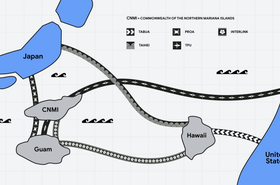A new subsea cable connecting Europe to Asia via the North Pole is being proposed by a group of Nordic education networks.
At the Subsea Networks EMEA event in London this week, Erik-Jan Bos, senior advisor at NORDUnet, outlined plans for the Polar Connect cable.
NORDUnet is the Nordic regional research and education network serving Norway, Finland, Sweden, Denmark, and Iceland.
The goal is to establish a subsea fiber route from Sweden via Norway and Svalbard through the North Pole to Japan, South Korea, and the Asia-Pacific region via the Bering Strait between Alaska and Russia.
Bos said the project aims to run the cable through the middle of the Arctic ice sheet, running just west of the Geographic North Pole.
He noted that Norway to Japan is only 10,000 km, but currently data has to travel the long way either west across the Atlantic and Pacific or East via Europe and Asia terrestrially or via the Indian Ocean. He said a new route would offer lower latencies and greater network resilience.
Bos said the project will look to incorporate SMART repeaters to enable greater scientific research of the Arctic seafloor.
It is one of two projects proposing to lay a subsea cable between Europe and Asia through Arctic waters. The 14,000km Far North Fiber (FNF) project will run from the Nordics to Japan, via Greenland, Canada, and Alaska as well as West Coast US. That cable aims to run via the Northwest Passage – a sea lane running through the Arctic Archipelago of Canada and south of Greenland – rather than through the geographic pole.
FNF is a joint venture between Cinia, US-based Far North Digital, and Japan’s Arteria Networks, with NORDUnet as an investor. It is set to feature 12 fiber pairs and scheduled to launch in 2027.
Rather than compete with Far North Fiber’s plans, Bos said the Polar Connect cable would complement the other proposed Arctic cable, offering resilience and diversity of route. It would likely land in many of the same places FNF aims to land, including Prudhoe Bay in Alaska.
Laying a subsea cable through the North Pole
A Northern EU Gateways project report from the Swedish Polar Research Secretariat (SPRS) suggested deployment of Polar Connect would require three ships; two heavy icebreakers (at Polar Class 2) and an ice-strengthened cable laying ship, with the icebreakers doing advanced ice management to keep the cable laying ship safe.
“Simulations and experience have shown that a route closer to the North Pole is shorter and less challenging due to lighter ice conditions than a route through the EEZ, north of Greenland,” a NORDUnet report said.
“Compared to the route closer to the North Pole, the Greenland route would require more powerful icebreakers and a higher ice-strengthened cable laying ship. The operation would also carry higher risks for the ships and the cable during the cable laying process.”
The Swedish Government currently owns one icebreaker suitable for assisting a cable-laying ship in the Arctic, the Oden, and is planning to commission a second in the next year or two (known as the Swedish Heavy Polar Research Vessel) for a potential 2028 delivery date.
A recent report suggested the cable could be laid in less than 80 days over late summer and early autumn in August or September, when conditions are most favorable. A third icebreaker may be needed to provide necessary redundancy during the operation. A rough cost estimate for the laying phase of the project is approximately 1.5 – 2.5 billion SEK ($142.5-237.5 million).
Bos noted the Arctic was made more challenging by the fact the changes every year, meaning routes that might be feasible one year may not be feasible the next.
Currently, there is no cable-laying ship suitable for autonomous use in heavy sea ice, and SPRS report suggests retrofitting an existing cable ship or reconfiguring a larger ice-class vessel (at Polar Class 3) for cable-laying to meet the requirements for icebreaker-assisted operations in the Arctic, since this will be “significantly more cost-efficient” than constructing a new ship. The Finnish icebreakers Fennica and Nordica have been identified as potential ships that could be converted.
The chance of fishing-related cable breaks were said to be low in ice-covered areas, but natural events still cause damage to cables. The report said cable repairs could be possible using a single heavy icebreaker fitted to host several kilometers of replacement cable and a Remotely Operated Vehicle (ROV) for underwater operations.
However, the full path of Arctic submarine cables is currently not covered by any of the submarine cable maintenance zones. The Atlantic Cable Maintenance Agreement (ACMA) goes north of Svalbard, but not across the North Pole and into the Canadian Archipelago.
NORDUnet, the Swedish Research Council (VR), and the Swedish Polar Research Secretariat received funding from the European Commission for the North Pole Fibre project late last year. The initial project, including surveys, will start in Q1 2024 and run for 3 years, with a total budget of €5.75 million. Funding has been awarded under the Backbone connectivity for Digital Global Gateways call as part of the 2nd round of the Connecting Europe Facility (CEF-2 Digital) program.







